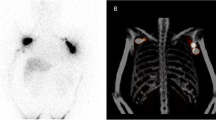Abstract
Purpose
With the purpose of minimizing arm lymphedema after axillary staging surgeries in breast cancer patients, the axillary reverse mapping (ARM) technique has been developed to identify and preserve arm drainage system during axillary surgery. This study aimed to clarify risk factors for metastasis in arm lymphatic drainage system in breast cancer patients with clinically negative axillary nodes.
Methods
Sixty-nine patients who underwent successful both sentinel lymph node (SLN) biopsy (SLNB) and ARM from October 2009 to August 2010 were enrolled in this study. Radioactive tracer was used for SLN localization and blue dye was used for ARM. All of the identified SLNs and ARM nodes were sent for pathological assessment.
Results
ARM nodes metastasis occured in 6 of 69 patients. Age, pathological tumor size (pT) and pathological lymph node status (pN) were not associated with ARM nodes metastasis (P > 0.01). Interestingly, in these 6 patients, all metastatic ARM nodes coincided with SLN-ARM nodes (hot SLN and blue ARM node were the same lymph node). In 50 of 69 patients whose ARM nodes did not coincided with SLNs, all ARM nodes were negative, even in 12 patients with metastatic SLNs.
Conclusion
Crossover between breast and ipsilateral arm lymphatic drainage system contributes for ipsilateral arm lymph node metastasis. When ARM and SLNB are simultaneously performed in a patient, selectively preservation of the ARM nodes that do not coincided with SLNs would be safe, even if the SLNs are positive. Pathological lymph node status does not account for the occurrence of metastasis in ARM nodes. ARM nodes could be preserved safely, independent of the pathological lymph node status.


Similar content being viewed by others
References
Bedrosian I, Babiera GV, Mittendorf EA, Kuerer HM, Pantoja L, Hunt KK, Krishnamurthy S, Meric-Bernstam F (2010) A phase I study to assess the feasibility and oncologic safety of axillary reverse mapping in breast cancer patients. Cancer 116(11):2543–2548
Boneti C, Korourian S, Bland K, Cox K, Adkins LL, Henry-Tillman RS, Klimberg VS (2008) Axillary reverse mapping: mapping and preserving arm lymphatics may be important in preventing lymphedema during sentinel lymph node biopsy. J Am Coll Surg 206(5):1038–1042 (discussion 1042–1044)
Boneti C, Korourian S, Diaz Z, Santiago C, Mumford S, Adkins L, Klimberg VS (2009) Scientific impact award: axillary reverse mapping (ARM) to identify and protect lymphatics draining the arm during axillary lymphadenectomy. Am J Surg 198(4):482–487
Britton TB, Solanki CK, Pinder SE, Mortimer PS, Peters AM, Purushotham AD (2009) Lymphatic drainage pathways of the breast and the upper limb. Nucl Med Commun 30(6):427–430
Casabona F, Bogliolo S, Ferrero S, Boccardo F, Campisi C (2008) Axillary reverse mapping in breast cancer: a new microsurgical lymphatic-venous procedure in the prevention of arm lymphedema. Ann Surg Oncol 15(11):3318–3319
Casabona F, Bogliolo S, Valenzano Menada M, Sala P, Villa G, Ferrero S (2009) Feasibility of axillary reverse mapping during sentinel lymph node biopsy in breast cancer patients. Ann Surg Oncol 16(9):2459–2463
Helyer LK, Varnic M, Le LW, Leong W, McCready D (2010) Obesity is a risk factor for developing postoperative lymphedema in breast cancer patients. Breast J 16(1):48–54
Klimberg VS (2008) A new concept toward the prevention of lymphedema: axillary reverse mapping. J Surg Oncol 97(7):563–564
Noguchi M, Yokoi M, Nakano Y (2010a) Axillary reverse mapping with indocyanine fluorescence imaging in patients with breast cancer. J Surg Oncol 101(3):217–221
Noguchi M, Yokoi M, Nakano Y (2010b) Axillary reverse mapping for breast cancer. Breast Cancer Res Treat 119(3):529–535
Nos C, Lesieur B, Clough KB, Lecuru F (2007) Blue dye injection in the arm in order to conserve the lymphatic drainage of the arm in breast cancer patients requiring an axillary dissection. Ann Surg Oncol 14(9):2490–2496
Nos C, Kaufmann G, Clough KB, Collignon MA, Zerbib E, Cusumano P, Lecuru F (2008) Combined axillary reverse mapping (ARM) technique for breast cancer patients requiring axillary dissection. Ann Surg Oncol 15(9):2550–2555
Ponzone R, Cont NT, Maggiorotto F, Cassina E, Mininanni P, Biglia N, Sismondi P (2009) Extensive nodal disease may impair axillary reverse mapping in patients with breast cancer. J Clin Oncol 27(33):5547–5551
Wilke LG, McCall LM, Posther KE, Whitworth PW, Reintgen DS, Leitch AM, Gabram SG, Lucci A, Cox CE, Hunt KK, Herndon JE 2nd, Giuliano AE (2006) Surgical complications associated with sentinel lymph node biopsy: results from a prospective international cooperative group trial. Ann Surg Oncol 13(4):491–500
Acknowledgments
We would like to thank Jieqiong Liu for her helpful discussion regarding this study and her useful comments on this manuscript. This work was supported by the National Natural Science Foundation of China (Grants number: 30972785, 30901767).
Author information
Authors and Affiliations
Corresponding author
Additional information
Heran Deng, Lun Chen, and Weijuan Jia contributed equally to this work.
Rights and permissions
About this article
Cite this article
Deng, H., Chen, L., Jia, W. et al. Safety study of axillary reverse mapping in the surgical treatment for breast cancer patients. J Cancer Res Clin Oncol 137, 1869–1874 (2011). https://doi.org/10.1007/s00432-011-1064-3
Received:
Accepted:
Published:
Issue Date:
DOI: https://doi.org/10.1007/s00432-011-1064-3




